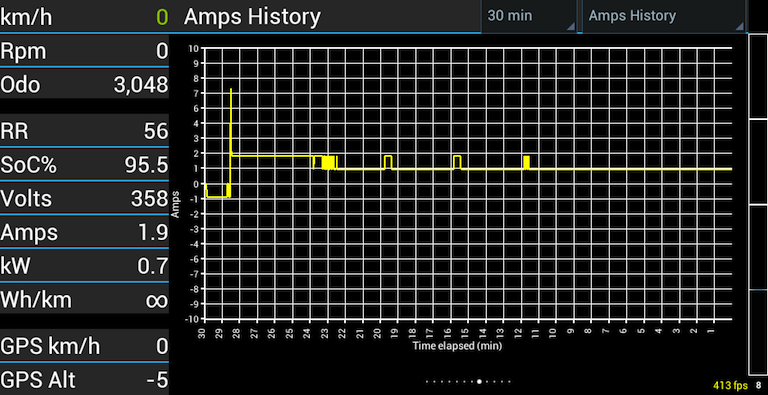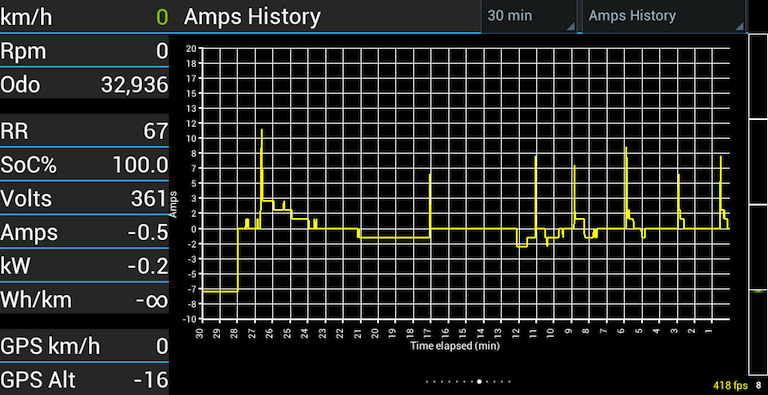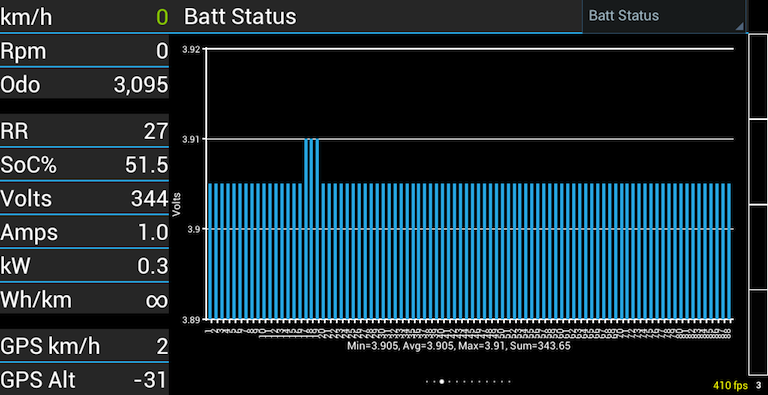DonDakin
Well-known member
Well canion has really been an eye opener.
There are a few things that I have learned.
First:
I use to think that the OEM L1 EVSE was about 900 watts going into the battery less the charger overhead. But it looks more like it's 500 watts. It also looks like the car overhead is about 300 watts give or take.
When the car is powered up and not moving it seems to draw about 1 battery amp.
That's just the basics no lights or ancillary equipment.
Second:
But more surprising is that when you select Preheat on L1 it actually draw about
2 amps from the battery. This is a surprise to me. I thought Preheat was free heat but not on level 1. Shame on you Mitsu..... All the more reason they should have provided a 12 amp L1 or a 120/240 L1/L2 capable EVSE. Very disappointing to think I was draining away the battery last winter during L1 preheat.
Now for L2
L2 charge battery current is 7 amps or about 2.5 KW. Where did the other .8 KW go ? Even if there is 300 watts of overhead required to power ancilary stuff we are still missing 500 Watts of power (that's a whole L1 OEM for god sakes......)
Hmmmmm.....
oh yeah wait a sec 90 % effeciency in the charger would explain that, Well that's good news.
As for preheat on L2 1 amp for the battery and the rest for the heater. That's reasonable.
Third:
That battery heats up on L1 charging. I am guessing all those little bypass mini heator resistors in there are heating up the battery chamber. After
9 hours of L1 charging I saw about 5 deg C above ambient. I was surprised because I expected with such a low current no heat to be generated but I'm thinking the heat is generated in the shunts.
Siai47 is right it's better to charge on L2 then L1. Charge time is faster/equalization/shunting time is shorter and I guess less heat is generated in the battery chamber with the faster times.
Fourth:
There is a hot spot in the battery, at least on my imiev. Its the third bar from the right on the battery temp display, always above the others when the battery is working.
Fifth:
Our little battery has a ton of thermal inertia.
Even with 16 Deg C of temp difference ( battery 24 deg C /ambient 8 Deg C) on a 15 Km gentle ride to work (30 minutes with traffic) the battery temp dropped only .2 deg on average. Maybe I should be thinking about how to extract heat from the battery and vent it into the cabin while I am on the road in winter.
I suppose the reverse is also true that a cold battery will tend to stay cold on those return trips from work in the winter. It will be interesting to check this out this winter.
All of this came from Canion and reading siai47's posts.
Anyways canion is a great app and wonderfull tool. It's like a step in the direction
of the Tesla instrumentation.....
Don.....
There are a few things that I have learned.
First:
I use to think that the OEM L1 EVSE was about 900 watts going into the battery less the charger overhead. But it looks more like it's 500 watts. It also looks like the car overhead is about 300 watts give or take.
When the car is powered up and not moving it seems to draw about 1 battery amp.
That's just the basics no lights or ancillary equipment.
Second:
But more surprising is that when you select Preheat on L1 it actually draw about
2 amps from the battery. This is a surprise to me. I thought Preheat was free heat but not on level 1. Shame on you Mitsu..... All the more reason they should have provided a 12 amp L1 or a 120/240 L1/L2 capable EVSE. Very disappointing to think I was draining away the battery last winter during L1 preheat.
Now for L2
L2 charge battery current is 7 amps or about 2.5 KW. Where did the other .8 KW go ? Even if there is 300 watts of overhead required to power ancilary stuff we are still missing 500 Watts of power (that's a whole L1 OEM for god sakes......)
Hmmmmm.....
oh yeah wait a sec 90 % effeciency in the charger would explain that, Well that's good news.
As for preheat on L2 1 amp for the battery and the rest for the heater. That's reasonable.
Third:
That battery heats up on L1 charging. I am guessing all those little bypass mini heator resistors in there are heating up the battery chamber. After
9 hours of L1 charging I saw about 5 deg C above ambient. I was surprised because I expected with such a low current no heat to be generated but I'm thinking the heat is generated in the shunts.
Siai47 is right it's better to charge on L2 then L1. Charge time is faster/equalization/shunting time is shorter and I guess less heat is generated in the battery chamber with the faster times.
Fourth:
There is a hot spot in the battery, at least on my imiev. Its the third bar from the right on the battery temp display, always above the others when the battery is working.
Fifth:
Our little battery has a ton of thermal inertia.
Even with 16 Deg C of temp difference ( battery 24 deg C /ambient 8 Deg C) on a 15 Km gentle ride to work (30 minutes with traffic) the battery temp dropped only .2 deg on average. Maybe I should be thinking about how to extract heat from the battery and vent it into the cabin while I am on the road in winter.
I suppose the reverse is also true that a cold battery will tend to stay cold on those return trips from work in the winter. It will be interesting to check this out this winter.
All of this came from Canion and reading siai47's posts.
Anyways canion is a great app and wonderfull tool. It's like a step in the direction
of the Tesla instrumentation.....
Don.....



























